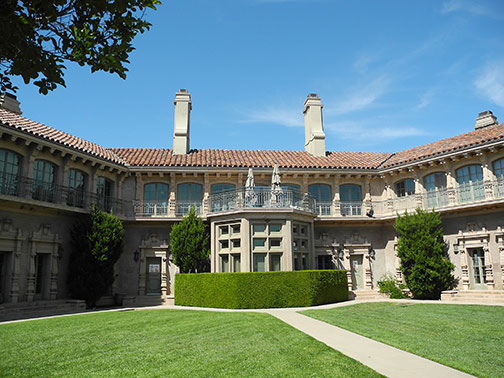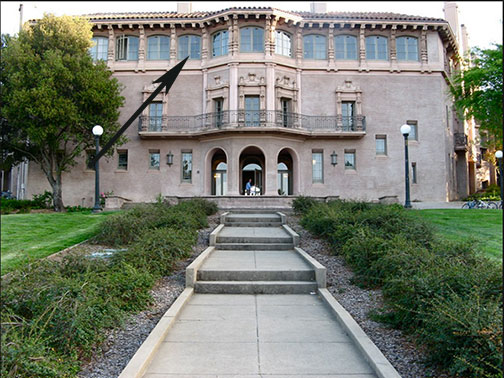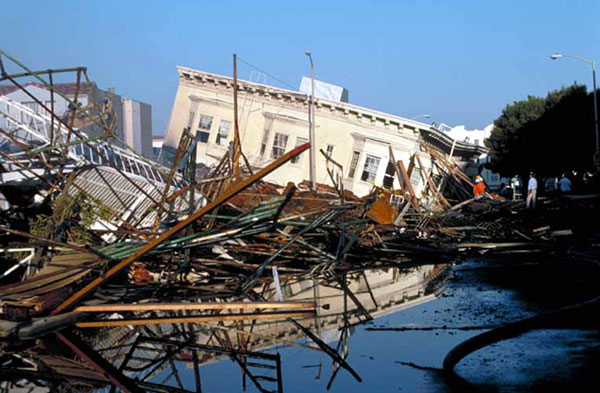HOME | FAMILY | CONDUCTING | SINGING | USU | STEINER | STANFORD | PHOTOS
26th AMENDMENT SIGNING | MEMORIES | YOUTUBE VIDEOS
Earthquakes
(We remember our earthquake experiences in 1989)
We moved to California in the summer of 1975 after I accepted an appointment to the faculty of Stanford University. We, of course, had long known about the seismic history of the state and had seen many photos of the great San Francisco quake of 1906. While we always knew that it was not a matter of "if" but rather "when" as the most professional seismologists frequently reminded us, it still was not an event that we thought about frequently.
My office was located on the 3rd floor of the music building, the Knoll. This was a majestic architectural achievement, which was situated on one of the highest areas of the campus, had originally served as the residence of the former president of Stanford, Ray Lyman Wilbur. The construction began in 1913 but, due to difficulties of World War I, it was not completed until 1918. The Knoll became the home of the Stanford Music Department in 1946 and remained so until the move to the Braun Music Center in 1984.

The Knoll as seen from the parking area
at the back of the building
Some work was being done in the parking area behind the knoll with a bulldozer repairing the gravel spaces. One morning I was in my office when suddenly there were strong shakings and loud bangings. I immediately left my office and inquired if the bulldozer had struck the building. I looked out toward the parking renovation and saw that the dozer was not near the building. Immediately it became obvious that the shaking and the noise had been caused by a significant earthquake. Abruptly, the shaking and noise stopped. Those of us in the building smiled and recalled the damage of 1906 and were thankful that this was not as strong as some previous quakes.

The arrow identifies my office in the Knoll
While we subsequently experienced minor quakes, it was not until the October 17, 1989 Loma Prieta earthquake that we had a more vivid first-hand understanding of the power of the moving tectonic plates under the surface of northern California. We were en route from our Stanford condo to our daughter's house in Santa Clara, only about a 15-minute drive, and noticed that some light poles seemed to be dancing. We did feel a kind of rolling as we drove to her home in our automobile. Traffic lights ceased to function and when we ultimately arrived, we asked what was going on.
Electricity was out throughout the bay area, but we could hear reports on battery-powered radios and learned that this appeared to be the "big one." Not only were there power outages, but bridges had collapsed and we were advised to shelter in place. After several hours of playing with our grandchild, we decided to attempt the trip back to our condo on the Stanford campus. Following instructions from the local and state police, we traveled only on "surface" streets, avoiding bridges, overpasses, etc. No traffic signals were functioning, so we had to be very careful at each intersection. The normally quick drive took us about 1½ hours to arrive back at our Stanford home.

Some San Francisco earthquake damage, 1989

Interstate 880 and 80 interchange bridge collapse in San Francisco, 1989
Although there was no electricity, we had several useful flashlights and we entered our condo with little difficulty. We went directly to bed and postponed the assessment of our damages until the next morning. When we awakened on October 18th, we still had no electrical power but our condo was filled with bright sunshine. Telephone service was non-existent (we had no mobile phones) but in spite of the lack of services, we were able to determine the losses we sustained. There were several antique figurines which showed minimal damage (broken glass antiques, lamps, etc.) We carefully opened each of our cabinets in an attempt to ascertain if any additional items were destroyed.
As I opened one of the kitchen cabinets, I was surprised to find an antique sugar bowl resting atop a small pile of sugar. The lid was on the bowl and there was no damage - all the sugar had been mysteriously thrust from the bowl and rested beneath the container. In addition, the lid was still in place atop the bowl!

This tragic earthquake resulted in 63 deaths, nearly 3,800 injuries, and an estimated $6 billion in property damage (equivalent to about $13 billion today.) It was the strongest earthquake to hit the area since the San Francisco earthquake of 1906. We were fortunate that we only lost a few possessions and some sugar.
